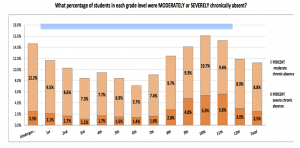School board leadership is essential to ensuring that schools are paying attention to chronic absence data and intervening when students are heading off track. But not all boards know where to start or how to calculate the data.
The California School Boards Association 5113.1 Chronic Absence and Truancy on chronic absence and truancy that suggests what roles superintendents and principals should play. While the policy is designed for California districts, it can provide a template for other places.
The model policy comes at an important time in California’s efforts to reduce chronic absence , which the state defines as missing 10 percent of the school year in excused or unexcused absences. The state education funding formula approved in 2013 requires school districts to track the data as a metric in the Local Control and Accountability Plan (LCAP). But so far, many districts haven’t begun to calculate the data. Attendance Works has developed California-specific data tools — the CalDATT and CalSATT — to help districts and schools crunch the numbers. And we’ve worked with the state Attorney General’s office and Eagle Software to ensure that the Aeries student data system can provide chronic absence data more easily.
Over the weekend, Attendance Works Director Hedy Chang gave a keynote presentation, Reducing Chronic Absence – An Overlooked Opportunity for Raising Student Achievement, at CSBA Directors At Large Joint Meeting in Sacramento. The 120-plus attendees were part of CSBA Delegate Assembly drawn from across California. The keynote was sponsored by the Joint Caucus representing Hispanic, African American, Native American and Asian American students, as well as counties.
If you’re a school board member, or a community member trying to engage your local school board, see our Frequently Asked Questions and ideas for celebrating Attendance Awareness Month in September.